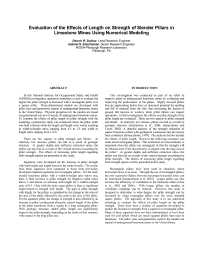Mining Publication: Evaluation of the Effects of Length on Strength of Slender Pillars in Limestone Mines Using Numerical Modeling
Original creation date: July 2007
In this NIOSH investigation, numerical modeling is used to evaluate the degree the pillar strength is increased with a rectangular pillar over a square pillar. Three-dimensional models are developed with pillar sizes and geometries typical of underground limestone mines in the United States. Physical properties for the models are based on geotechnical surveys of nearly 30 underground limestone mines. To examine the effects of pillar length on pillar strength with the modeling, a parametric study was conducted where the pillar width was held constant while the length and height were varied resulting in width-to-height ratios ranging from 0.5 to 1.5 and width to length ratios ranging from 1 to 6. There are two aspects to pillar strength and failure. At relatively low stresses, pillars can fail as a result of geologic structure. At greater depths and sufficient extraction ratios, the pillars can also fail as a result of the vertical stresses exceeding the pillar strength. The effects of increasing pillar length regarding both strength aspects are presented in this study. Equations were developed for the increase in pillar strength with both height and length based on the model results. The results from these equations were compared to those from previously developed empirical equations for rectangular pillars. For the more slender limestone pillars with a width-to-height ratio below one, there is little increase in pillar strength for length-to-width ratios above 2 and almost no increase with length for a width-to-height ratio of 0.5. Only with the more squat pillars is there a significant improvement in strength with length. The gain in pillar strength with length for the pillars is explained by the change in the ratio of the area of the pillar affected by the ends to the area of the pillar. For the squattest pillar, the change in strength is also affected by an increase in pillar confinement along the central length of the pillar as the pillar transitions from a square to a long rectangular pillar. With geologic structure, added pillar length can significantly improve the pillar strength, depending on the strike of that structure with respect to the long pillar axis.
Authors: DR Dolinar, GS Esterhuizen
Conference Paper - July 2007
NIOSHTIC2 Number: 20032438
Proceedings of the 26th International Conference on Ground Control in Mining, July 31 - August 2, 2007, Morgantown, West Virginia. Peng SS, Mark C, Finfinger G, Tadolini S, Khair AW, Heasley K, Luo Y, eds., Morgantown, WV: West Virginia University, 2007; :304-313
See Also
- Assessment of Stable and Failed Pillars in Underground Limestone Mines
- Coal Bumps and Odd Dynamic Phenomena - A Numerical Investigation
- Effects of Weak Bands on Pillar Stability in Stone Mines: Field Observations and Numerical Model Assessment
- Evaluation of the Strength of Slender Pillars
- In Situ Stress Measurements Near the Ross Shaft Pillar, Homestake Mine, South Dakota
- Investigation of Pillar-Roof Contact Failure in Northern Appalachian Stone Mine Workings
- Observations and Evaluation of Floor Benching Effects on Pillar Stability in U.S. Limestone Mines
- Pillar Stability Issues Based on a Survey of Pillar Performance in Underground Limestone Mines
- Proceedings: New Technology for Ground Control in Multiple-seam Mining
- Propagation of UHF Radio Waves in Limestone Room and Pillar Mines
- Page last reviewed: 4/1/2015
- Page last updated: 4/1/2015
- Content source: National Institute for Occupational Safety and Health, Mining Program


 ShareCompartir
ShareCompartir
